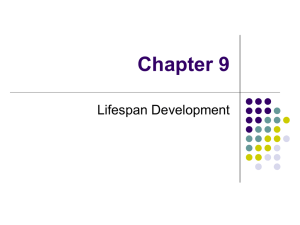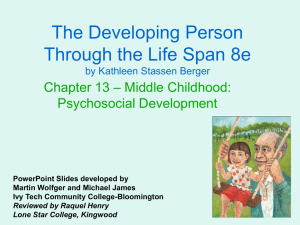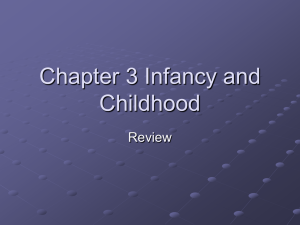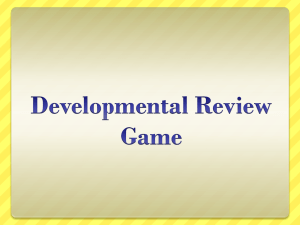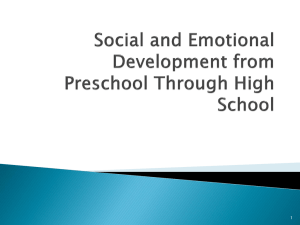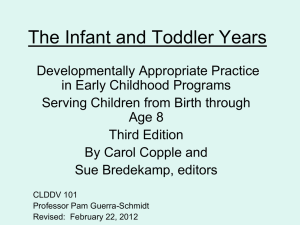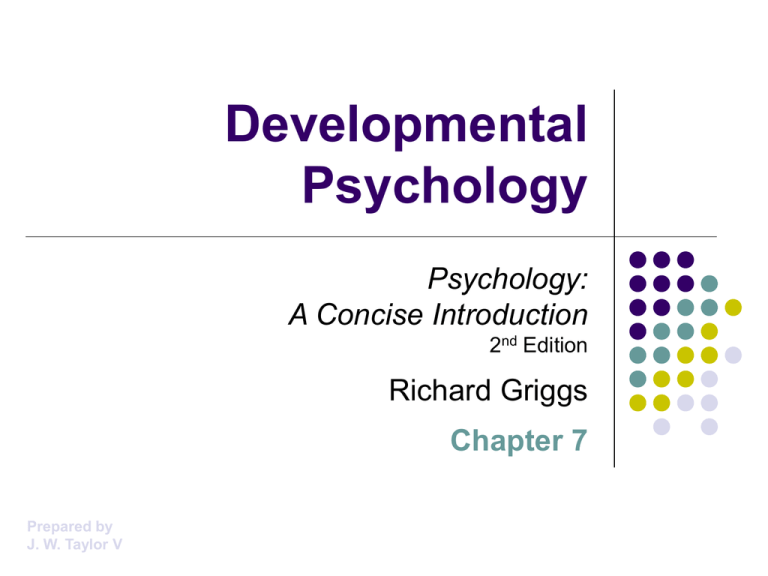
Developmental
Psychology
Psychology:
A Concise Introduction
2nd Edition
Richard Griggs
Chapter 7
Prepared by
J. W. Taylor V
Developmental Psychology
The scientific study of biological, cognitive,
social, and personality development
throughout the life span
A major issue in developmental psychology is
the nature-versus-nurture question
Do our traits and behaviors
result from heredity (nature) or
the environment (nurture)?
Seven Stages of Development
Prenatal
Conception to Birth
Infancy
Birth to 2 years
Childhood
2 to 12 years
Adolescence
12 to 18 years
Young Adulthood
18 to 40 years
Middle Adulthood
40 to 65 years
Late Adulthood
65 years and over
The Journey…
Prenatal Development and
Infancy
How We Think Throughout Our
Lives
Moral Development and Social
Development
Prenatal Development
and Infancy
Prenatal
Development
How We Develop
During Infancy
Prenatal Development
Human conception begins when a sperm
penetrates the membrane of an ovum
When the two combine, a complete set of
genetic instructions is formed, half from the
father and half from the mother
The fertilized egg that is formed from the
union of the sperm and egg is called a
zygote
The Gene
The basic unit of genetic instructions
Genes are short segments of chromosomes,
molecules of DNA that hold the genetic
instructions for every cell in our body
Every cell of a normal human has 23 pairs
of chromosomes, one of each pair coming
from
the mother and one from the father
Sex Determination
It is the 23rd pair of chromosomes
that determines a person’s sex
In a female, there are two
X-shaped chromosomes (XX)
In a male, there is one X-shaped chromosome
and one smaller Y-shaped chromosome (XY)
It is the Y chromosome that leads to the
development of a male, so the sex of the zygote
is determined by which sperm X or Y, fertilizes
the egg
Twins
Sometimes the growing cluster of
duplicated cells breaks apart early in
development resulting in two clusters with
identical genes
These clusters become identical
(monozygotic) twins because they come
from the same zygote
Twins
Fraternal (dizygotic) twins originate from
the fertilization of two eggs at about the
same time
Chance determines which of the 23 pairs of
chromosomes goes to a reproductive cell, so
there are about 8 million chromosome possibilities
for each reproductive cell in each parent
Consequently, fraternal twins, as well as any two
children of the same parents, may vary greatly in
appearance
Stages of Prenatal Development
Germinal
Begins with the formation of the zygote and
ends after about 2 weeks, when the outer
portion of the zygote’s developing cluster of
cells has attached itself to the uterine wall
Embryonic
From 2 weeks to about 2 months, the major
structures and organs of the body begin to
develop, and the embryo starts to resemble a
human being
Fetal
From about 2 months to birth, the developing
organism is called a fetus, and through very
rapid growth, the body structures and organs
complete their growth
Influences
Prenatal development is mainly a function of
the zygote’s genetic code (nature), but the
environment (nurture) also plays a role
Teratogens are environmental agents
(such as drugs or viruses), diseases (such
as German measles), and physical
conditions (such as malnutrition) that impair
prenatal development and lead to birth
defects or even death
How We Develop During Infancy
Motor
Development
SensoryPerceptual
Development
Motor Development
A reflex is an unlearned response to a
specific stimulus
The Babinski reflex occurs when an infant
fans her toes upward when her feet are
touched
The grasping reflex occurs when an infant
grasps any object that touches their palms
The sucking reflex leads an infant to suck
anything that touches its lips
The rooting reflex leads an infant to turn
its mouth toward anything that touches its
cheeks and search for something to suck
Sensory-Perceptual Development
Preferential-looking technique is used to
study vision
Two visual stimuli are displayed side by side,
and the researcher records how long the infant
looks at each stimulus
If the infant looks at one stimulus longer, it is
inferred he can tell the difference between the
two stimuli and has a preference
Sensory-Perceptual Development
Habituation is a decrease in the physiological
responding to a stimulus once it becomes
familiar
Infants, for example, tend to look longer at novel
stimuli
If infants look longer at a new stimulus than an old
one, then it is inferred he must be able to perceive
the difference between the two stimuli
Infants also intensity their sucking of a pacifier in
their mouths when confronted with a novel stimulus
Sensory-Perceptual Development
Vision is the least-developed sense
at birth
Newborns’ visual acuity is estimated to
be about 20/400 to 20/800
Visual acuity reaches 20/20 within the
first year of life
Color vision develops by 2 to 3 months
Infants’ preference for visual complexity
may be due to the fact that such
stimulation is necessary for proper
development of the visual pathways
and cortex during infancy
Sensory-Perceptual Development
Hearing in the newborn is more fully
developed than vision
Can distinguish their mother’s voice from those
of others
This ability appears to develop in the womb
before birth
By 6 months, an infant’s hearing is comparable
to that of an adult
Sensory-Perceptual Development
The senses of smell, taste, and touch are
also fairly well-developed at birth
Infants can differentiate the smell of their
mother from those of other people
Very young infants may have an innate
conceptual understanding of object
movement (e.g., that objects cannot go
through solid surfaces)
Sensory-Perceptual Development
The brain contains about 100 billion
neurons at birth, but the infant’s brain is
immature, and connections between
neurons (neural networks) need to be
formed
Without visual experiences, the visual pathways
do not develop, and vision will be permanently
lost
During infancy, the networks of neurons that are
used become stronger and those that are not
used disappear
How We Think
Throughout Our Lives
How We Learn Language
Piaget’s Theory of
Cognitive Development
Vygotsky’s Sociocultural
Approach to Development
How Intelligence Changes in Adulthood
How We Learn Language
No other animal seems to be able to
acquire and develop language ability as
humans do
Children in different cultures learn to speak
very different languages, but they all seem
to go through the same sequence of stages
Language Stages
Infants communicate through crying, with
different cries for hunger and for pain, and
through movement and facial expressions
Prefer baby talk (or motherese) – the different
format of speech that adults use when talking
with babies that involves the use of shorter
sentences with a higher, more melodious pitch
than normal speech
Language Stages
At about 6 or 7 months, babbling, the
rhythmic repetition of various syllables,
including both consonants and vowels, begins
At about 1 year of age, the infant begins to
speak a few words, which usually refer to
their caregivers and objects in their daily
environment
Infants use holophrases, words that express
complete ideas
Language Stages
Vocabulary grows slowly until about 18 months,
and then infants learn about 100 words or more
per month
Overextension: The application of a newly
learned word to objects that are not included in the
meaning of the word (e.g., calling any female
person “mama”)
Underextension: The failure to apply the new
word more generally to objects that are included
within the meaning of the new word (e.g., not
extending the category of “dog” to include dogs
that are not the family pet)
Language Stages
Between 18 and 24 months, children
experience a vocabulary-acquisition spurt
and words are combined into sentences
Telegraphic speech is the use of 2-word
sentences with mainly nouns and verbs (e.g.,
“Dada eat” for “Dad is having dinner”)
These 2-word statements begin to be expanded
and between the ages of 2 and 5 years, the
child implicitly acquires grammar of the native
language
Language Stages
Language development is a genetically
programmed ability
However, this ability is not developed without
exposure to human speech
Thus, both nature and nurture are vital to
language development
Piaget’s Theory of
Cognitive Development
Piaget did not conduct formal experiments, but
rather loosely structured interviews in which he
posed problems for children to solve, observed
their actions carefully, and questioned them
about their solutions
Was particularly interested in children’s error, which
would provide insights into children’s thought
processes
Assumed that a child is an active
seeker of knowledge and gains an understanding of
the world by operating on it
Schemas
Organized units of knowledge about
objects, events, and actions
Cognitive adaptation
involves two processes
Assimilation is the
interpretation of new
experiences in terms of
present schemes
Accommodation is the
modification of present
schemes to fit with new
experiences
Schemas
For example, a child may call all fourlegged creatures “doggie”
The child learns he needs to accommodate
(i.e., change) his schemes, as only one type of
four-legged creature is “dog”
It is through accommodation that the number
and complexity of a child’s schemes increase
and learning
occurs
Piaget’s Stages of
Cognitive Development
Sensorimotor
Birth to 2 years
Preoperational
2 to 6 years
Concrete operational 6 to 12 years
Formal operational
12+ years
Piaget’s Stages of
Cognitive Development
Sensorimotor Stage
Infant learns about the world through their
sensory and motor interactions (including
reflexes)
Lack object permanence, the knowledge than
an object exists independent of perceptual
contact
Symbolic representation of objects and events
starts to develop during the latter part of the
sensorimotor stage (e.g., use of telegraphic
speech)
Preoperational Stage
The child’s thinking becomes more symbolic
and language-based, but remains egocentric
and lacks the mental operations that allow
logical thinking
Egocentrism is the inability to distinguish
one’s own perceptions, thoughts, and feelings
from those of others
Cannot perceive the world from another person’s
perspective
The child, however, can pretend, imagine, and
engage in make-believe play
Preoperational Stage
Conservation is the knowledge that the quantitative
properties of an object (such as mass, volume, and
number) remain the same despite changes in
appearance
Some grasp of conservation
marks the end of the
preoperational stage and
the beginning of the
concrete-operational stage
The liquid/beakers problem
is a common test of
conservation ability
Preoperational Stage
A major reason why a preoperational child
does not understand conservation is that the
child lacks an understanding of reversibility,
the knowledge that reversing a transformation
brings about the conditions that existed
before the transformation
Child’s thinking also reflects centration, the
tendency to focus on only one aspect of a
problem at a time
Tests of Conservation
Concrete Operational Stage
Children gain a fuller understanding of
conservation and other mental operations that
allow them to think logically, but only about
concrete events
Conservation for liquids, numbers, and matter
acquired early, but conservation of length
acquired later in the stage
Develops transitivity (e.g., if A > B, and B > C,
then A > C)
Develops seriation, the ability to order stimuli
along a quantitative dimension (e.g., a set of
pencils by their length)
The reasoning of concrete operational
children is tied to immediate reality (i.e., what
is in front of them and tangible) and not with
the hypothetical world of possibility
Formal Operational Stage
The child gains the capacity for
hypothetical-deductive thought
Can engage in hypothetical
thought and in systematic
deduction and testing of
hypotheses
Formal Operational Stage
In one scientific thinking task, the child is shown several flasks
of what appear to be the same clear liquid and is told one
combination of two of these liquids would produce a clear liquid
The task is to determine which combination
would produce the blue liquid
The concrete operational child just starts
mixing different clear liquids together
haphazardly
The formal operational child develops a
systematic plan for deducing what the
correct combination must be by determining
all of the possible combinations and then
systematically testing each one
Formal Operational Stage
The formal operational child can evaluate the
logic of verbal statements without referring to
concrete situations
For example, the formal
operational child would
judge the statement “If mice
are bigger than horses, and
horses are bigger than cats,
then mice are bigger than
cats” to be true, even
though in “real life” mice are
not bigger than cats
Evaluation of Piaget’s Theory
Recent research has shown that rudiments
of many of Piaget’s key concepts (e.g.,
object permanence) may begin to appear at
earlier stages than Piaget proposed
For example, research that involved tracking
infants’ eye movements has found that infants
as young as 3 months continue to stare at the
place where the object disappeared from sight,
indicating some degree of object permanence
Evaluation of Piaget’s Theory
1. Not all people reach formal operational
thought
2. The theory may be biased in favor of
Western culture
3. There is no real theory of what occurs
after the onset of adolescence
4. Despite refinements, recent research has
indeed shown that cognitive
development seems to proceed in the
general sequence of stages that Piaget
proposed
Vygotsky’s Sociocultural
Approach to Development
Stressed that cognitive abilities develop through
interactions with others and represent the shared
knowledge of one’s culture
The zone of proximal development is the
difference between what a child can actually do and
what the child could do with the help of others (i.e.,
potential development less actual development)
In scaffolding, the parent or teacher adjusts the
level of help in relation to the child’s level of
performance, while directing the child’s learning
progress toward the upper level of her zone of
proximal development
How Intelligence
Changes in Adulthood
Two methods for studying intelligence changes
In a cross-sectional study, people of different ages are
studied and compared with one another
In a longitudinal study, the same people are studied
over a long period of time
The cross-sectional method consistently finds that
intelligence declines with age
However, using the longitudinal method, later studies
found that intelligence did not decline with age, but
remained rather stable and even increased until
very late in life when it showed a decline
How Intelligence
Changes in Adulthood
Problem with cross-sectional research
Cohort effect – people of a given age are affected by
factors unique to their generation (e.g., differences in
educational opportunities), leading to differences in
performance between generations
Problems with longitudinal research
Time consuming
Expensive
Repeated testing necessary
Participants die/drop out of the research
Those who participate over the entire course of the
research may have been the most intelligent and
healthiest participants whose intelligence would be the
most likely not to decline
Types of Intelligence
Crystallized intelligence refers to
accumulated knowledge, verbal skills,
and numerical skills that increase
with age
Fluid intelligence involves
abilities such as abstract
thinking, logical problem
solving, and spatial reasoning
that decrease with age
Types of Intelligence
The Seattle Longitudinal Study is a major
attempt to learn if intelligence declines with age
Started in 1956 with more than 5000 participants being
tested every 7 months through 1998
Groups of new participants were added periodically,
making the research part cross-sectional and part
longitudinal
Found that most intellectual abilities decline somewhat
by age 60, but the decline is not great until a person
reaches age 80 or more
Those who suffer the least decline are those who
stayed healthy, of higher socioeconomic status, and
are in intellectually stimulating environments
Moral Development and
Social Development
Kohlberg’s Theory of
Moral Reasoning
Attachment and
Parenting Styles
Erikson’s Psychosocial Stage
Theory of Development
Kohlberg’s Theory
of Moral Reasoning
Built on an earlier theory of moral reasoning
proposed by Piaget, using a series of stories
that involved moral
dilemmas to assess a
person’s level of moral
reasoning
Discerned three levels of
moral reasoning based
on responses to the
stories and the reasoning
behind the responses given
Kohlberg’s Levels
of Moral Reasoning
1. At the preconventional level of moral reasoning,
the emphasis is on avoiding punishment and looking
out for your own welfare and needs
Moral reasoning is self-oriented
2. At the conventional level of moral reasoning, moral
reasoning is based on social rules and laws
Social approval and being a dutiful citizen are important
3. At the highest level, the postconventional level of
moral reasoning, moral reasoning is based on selfchosen ethical principles
Human rights taking precedent over laws; the avoidance of
self-condemnation for violating such principles
Kohlberg’s Levels
of Moral Reasoning
Level 1 Preconventional Morality
Stage 1 Punishment Compliance with rules to
orientation avoid punishment
Stage 2 Reward
orientation
Compliance with rules to
obtain rewards and satisfy
own needs
Kohlberg’s Levels
of Moral Reasoning
Level 2 Conventional Morality
Stage 3 Good-girl/
good-boy
orientation
Engages in behavior to get
approval of others
Stage 4 Law and
order
orientation
Behavior is guided by duty
to uphold laws and rules
for their own sake
Kohlberg’s Levels
of Moral Reasoning
Level 3 Postconventional Morality
Stage 5 Social
contract
orientation
Obeys rules because they
are necessary for social
order but understands
rules are relative
Stage 6 Universal
ethical
principles
orientation
Concerned about selfcondemnation for violating
universal ethical principles
based on human rights
Kohlberg’s Theory
of Moral Reasoning
Kohlberg proposed that we all start at the
preconventional level as children and as we
develop, especially cognitively, we move up
the ladder of moral reasoning
The sequence is uniform; however, not
everyone reaches the postconventional level
Kohlberg’s Theory
of Moral Reasoning
Shortcomings of Kohlberg’s theory
Studied moral reasoning and not moral
behavior
May not have adequately represented
the morality of women
The higher stages may be biased toward
Western cultures
Attachment and Parenting Styles
Attachment is the lifelong emotional bond
that exists between the infants and their
mothers or other caregivers, formed during
the first six months of life
Attachment and
Harlow’s Monkeys
Harry Harlow separated infant monkeys
from their mothers at birth and put them in
cages containing two inanimate surrogate
mothers, one made of wire and one made of
terry cloth
Attachment and
Harlow’s Monkeys
Half of the monkeys received their nourishment
from a milk dispenser in the wire and half from
a dispenser in the terry cloth mother
All of the monkeys preferred the cloth monkey
regardless of which monkey provided their
nourishment
The monkeys being fed by the wire mother would
only go to the wire mother to eat and then return
to the cloth mother
Thus, “contact comfort,” not reinforcement from
nourishment, was the crucial element for
attachment formation
Attachment and
Harlow’s Monkeys
Attachment and
Harlow’s Monkeys
When confronted with a strange situation
(e.g., an unfamiliar room with toys) without
the surrogate mother, the infant monkey
would be fearful
When the surrogate mother was brought into the
strange situation, the infant monkey would initially
cling to the terry cloth mother to reduce its fear,
but then begin to explore the new environment
and eventually play with toys
Types of Attachment
Discerned via the strange situation devised by
Ainsworth, in which an infant’s behavior is observed
in an unfamiliar room with toys, while the infant’s
mother or caregiver and a stranger move in and out
of the room in a structured series of simulations
Insecureavoidant
Secure
Insecureambivalent
Insecuredisorganized
Types of Attachment
Secure attachment is indicated when an infant explores
the situation freely in the presence of the mother, but
displays distress when the mother leaves, and responds
enthusiastically when the mother returns
Caregivers who are sensitive and responsive to an infant’s needs
are more likely to develop a secure attachment with the infant
Insecure-avoidant attachment
is indicated by exploration, but
minimal interest in the mother,
the infant showing little
distress when the mother
leaves, and avoiding her
when she returns
Types of Attachment
Insecure-ambivalent attachment is indicated by
the infant seeking closeness to the mother and not
exploring the situation, high level of distress when
the mother leaves, and ambivalent behavior when
she returns by alternately clinging to and pushing
away from her
Insecure-disorganized (disoriented)
attachment is marked by the infant’s confusion
when the mother leaves and when she returns
The infant acts disoriented, seems overwhelmed by
the situation, and does not demonstrate a consistent
way of coping with it
Types of Attachment
Infant temperament, a set of innate tendencies or
dispositions that lead us to behave certain ways, is also
a factor in determining type of attachment
Specifically, how an infant’s
temperament matches the childrearing expectations and personality
of its caregiver is important in
forming the attachment relationship
Secure attachments have been
linked to higher levels of cognitive
functioning and social competence
in adulthood
Daycare does not appear to be
detrimental to the formation of secure attachments
Parenting Styles
Authoritarian Parents are demanding, expect unquestioned
obedience, are not responsive to their children’s
desires, and communicate poorly with their children
Authoritative Parents are demanding but set rational limits for
their children and communicate well with their
children
Permissive
Parents make few demands and are overly
responsive to their child’s desires, letting their
children do pretty much as they please
Uninvolved
Parents minimize both the time they spend with the
children and their emotional involvement with them,
doing little more than providing for basic needs
Parenting Styles
An authoritative parenting style seems
to have the most positive effect on
cognitive and social development
Children are the most independent, happy,
self-reliant, and academically successful of
the four parenting styles
Erikson’s Psychosocial
Stage Theory of Development
Emphasized the impact of society and
culture upon development
Lead to an increase in research on lifespan development
Criticized for the lack of solid
experimental data to support it
Eight stages of development, each
with a major issue or crisis that has to
be resolved
Each stage is named after the two sides
of the issue relevant in that stage
Erikson’s Psychosocial Stages
1
Trust vs. Mistrust
(birth to 1 year)
Infants learn that they can or
cannot trust others to take
care of their basic needs
2
Autonomy vs. Shame
and Doubt
(1 to 2 years)
Children learn to be selfsufficient in many activities
such as toilet training,
walking, and exploring; if
restrained too much they
learn to doubt their abilities
and feel shame
Erikson’s Psychosocial Stages
3
Initiative vs. Guilt
(3 to 5 years)
Children learn to assume
more responsibility by taking
the initiative but will feel
guilty if they overstep limits
set by parents
4
Industry vs. Inferiority
(5 years to puberty)
Children learn to be
competent by mastering new
intellectual, social, and
physical skills or feel inferior
if they fail to develop these
skills
Erikson’s Psychosocial Stages
5
Identity vs. Role
Confusion
(adolescence)
Adolescents develop a sense
of identity by experimenting
with different roles; no role
experimentation may result in
role confusion
6
Intimacy vs. Isolation
(young adulthood)
Young adults form intimate
relationships with others or
become isolated because of
failure to do so
Erikson’s Psychosocial Stages
7
Generativity vs.
Stagnation
(middle adulthood)
Middle-aged adults feel they
are helping the next generation
though their work and child
rearing, or they stagnate
because they feel that they are
not helping
8
Integrity vs. Despair
(late adulthood)
Older adults assess their lives
and develop sense of integrity
if they find lives have been
meaningful; develop sense of
despair if not meaningful
Erikson’s Psychosocial
Theory of Development
Probably the greatest impact of Erikson’s theory is
that it expanded the study of developmental
psychology past adolescence into the stages of
adulthood (young, middle, and late)
The sequence in the theory (intimacy issues
followed by identity issues) turns out to be the most
applicable to men and career-oriented women
Many women may solve these issues in reverse order or
simultaneously
For example, a woman may marry and have children
and then confront the identity issues when the children
become adults

